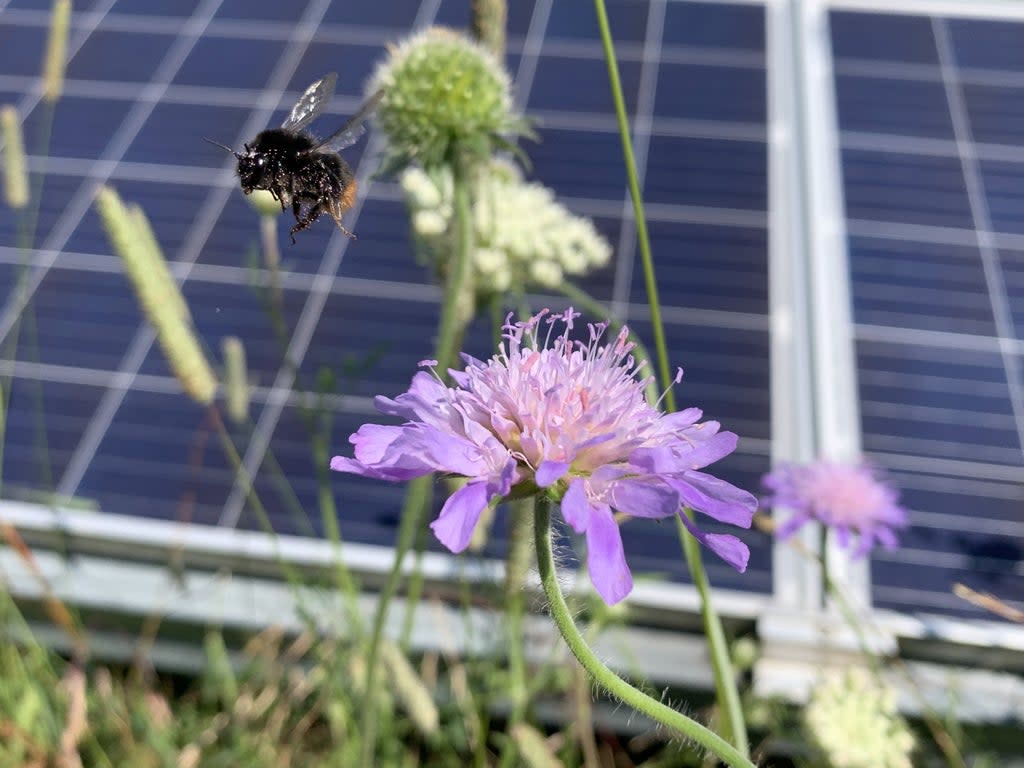Solar parks may boost bumblebee population in UK

Making simple changes to the way solar parks in the UK are managed could boost nesting bumblebee populations in parks and surrounding areas, new research shows.
As well as being an effective source of renewable energy, the researchers from Lancaster University found that solar parks managed as meadows – offering the most resources – would support four times as many bumblebees as solar parks managed as turf grass.
Their findings also indicated the potential to increase the number of bumblebees could also provide potential benefits to nearby crops through enhanced pollinator visitation.
The researchers have suggested that farmers who have solar parks on or near to their land could plant pollinator-dependent crops close to these pollinator dense areas to make the most of the growing bee population.
Hollie Blaydes, a PhD researcher at Lancaster University who will present the results at the Ecology Across Borders conference today, said that solar parks could become “conservation tools” and “valuable” habitats for bumblebees.
“Our findings provide the first quantitative evidence that solar parks could be used as a conservation tool to support and boost pollinator populations,” she said. “If they are managed in a way that provides resources, solar parks could become valuable bumblebee habitat.
“In the UK, pollinator habitat has been established on some solar parks, but there is currently little understanding of the effectiveness of these interventions.
“Our findings provide solar park owners and managers with evidence to suggest that providing floral and nesting resources for bumblebees could be effective.”
Currently in the UK, solar parks are generally located within intensively managed agricultural landscapes, raising the potential of solar parks as refuges for bumblebees.
According to a report from the British Ecological Society, the area of land used for solar parks in the UK is also growing, increasing the potential to use this land for additional benefits.
Ground-mounted solar parks currently occupy 14,000 hectares. If Britain is to meet its net-zero targets, the Climate Change Committee has said that there will need to be an additional 54GW of solar photovoltaic, meaning a land-use change of 90,300 hectares for solar parks.
At present, one barrier to solar parks being managed in ways that benefit pollinators is financial, with no current economic incentives being offered within the solar sector to make these changes.
It’s hoped that the post-Brexit agricultural bill payments for ecosystem services could provide a mechanism for this, the British Ecological Society said, adding that business structures could also prove to be a hindrance.
Ms Blaydes said: “Management of solar parks is often outsourced to external companies where contracts are typically around two years long.
“This, along with frequent changes in ownership, means that management regimes could be changed as the solar park or management contract changes hands. This could be challenging when trying to establish and maintain habitats over longer time scales.”
Ms Blaydes will present the work at the Ecology Across Borders conference, where 1,000 ecologists will meet to discuss the most recent breakthroughs in ecology.
This work is unpublished and is currently under review.
Read More
Opinion: Police bill is an unprecedented assault – Priti Patel must be stopped
Farmed seafood supply ‘at risk if we don’t act on climate change’
Kentucky tornado leaves six children dead – follow live
Opinion: Police bill is an unprecedented assault – Priti Patel must be stopped
Farmed seafood supply ‘at risk if we don’t act on climate change’

 Yahoo News
Yahoo News 
